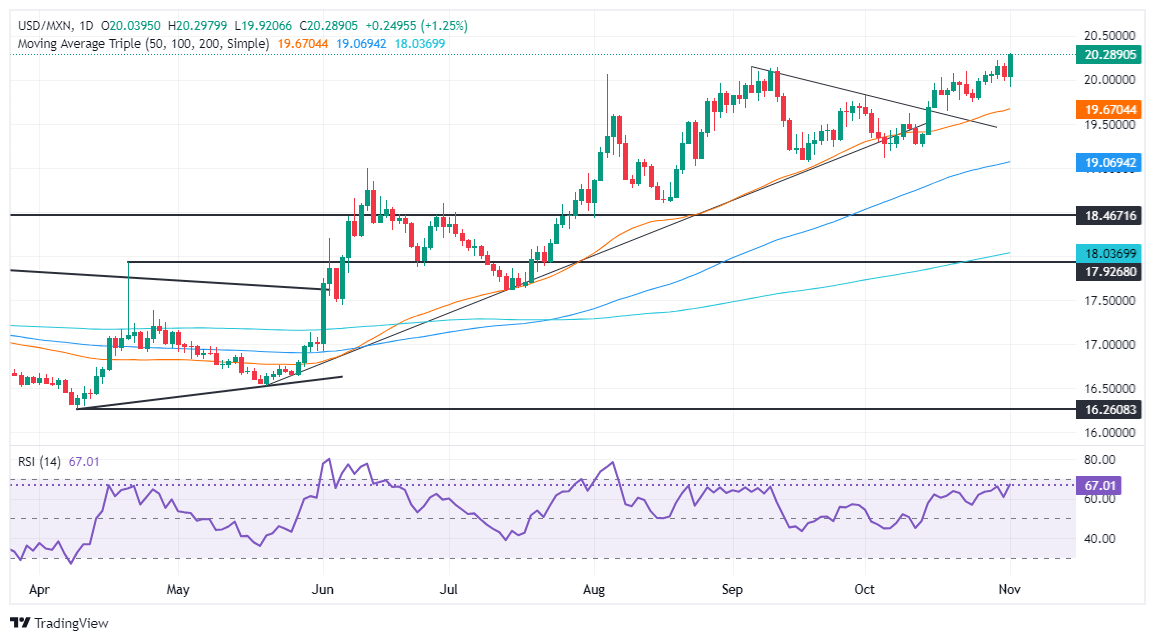- The Mexican Peso plummets while the USD/MXN rises more than 1.50% weekly, reaching new annual highs.
- US Dollar Index rises as Treasury yields jump, boosting dollar strength.
- Economic data from Mexico shows resilience, but US elections add uncertainty for emerging market currencies.
The Mexican Peso depreciated sharply against the Dollar on Friday and recorded new annual highs of 20.29, above the previous peak of 20.22 at the end of the North American session, with weekly losses of more than 1.50%. A hectic calendar on both sides of the Rio Grande showed positive figures in Mexico. In contrast, US employment data was disappointing, while manufacturing activity contracted. USD/MXN is trading at 20.26, up 1.20%.
Mexico’s calendar revealed that Business Confidence improved in October, while the Unemployment Rate remained below the 3% threshold. S&P Global revealed that manufacturing activity continued to expand. Foreign currency reserves increased, announced the Bank of Mexico (Banxico), which revealed its private survey that showed that the majority of economists predict that the economy will grow half of what was estimated in January, at a rate of 1.4%.
In the US, the Bureau of Labor Statistics (BLS) released nonfarm payrolls numbers for October, which were worse than expected. The BLS cited several hurricanes and union strikes as being responsible for the discouraging report. After that, the Institute of Supply Management (ISM) manufacturing PMI fell to its lowest level since July 2023.
USD/MXN soared after the data, boosted by the US Dollar Index (DXY), which tracks the US currency against six other currencies. The index rose 0.41% to 104.31. The Dollar was supported by a late jump in US Treasury yields, with the 10-year note ending at 4.38%, up ten basis points on the day.
Apart from this, the upcoming US presidential elections could put pressure on the emerging market currency. The close race for the White House between former President Donald Trump and Vice President Kamala Harris is keeping investors nervous, who, according to Bloomberg, turned to long positions in Dollars before the result.
Daily Market Summary: Mexican Peso Pressured Ahead of US Elections
- The USD/MXN continues to drift due to political turmoil in Mexico following the approval of the controversial judicial reform. Eight of the eleven judges of the Supreme Court announced their resignation effective in August 2025.
- Meanwhile, remittances in Mexico recorded their biggest drop in eleven years in September, falling 4.6% compared to the same month last year, according to the Bank of Mexico. Remittances reached 5.36 billion dollars, less than the 5.62 billion recorded in the same month last year.
- Mexico’s Business Confidence in October improved from 52.1 to 52.3. S&P Global revealed that the manufacturing PMI for the same period remained in contraction territory, despite improving. The index rose from 47.30 to 48.4.
- The US Bureau of Labor Statistics (BLS) reported that nonfarm payrolls in October were affected by severe hurricanes and union strikes. The U.S. economy added just 12,000 jobs, well below the estimated 113,000. Despite this, the unemployment rate remained stable at 4.1%, as traders await additional economic data.
- The Institute for Supply Management (ISM) reported that manufacturing activity declined for the seventh consecutive month, hitting its lowest level since July 2023. The ISM Manufacturing PMI fell from 47.2 to 46.5, missing forecasts of 47.6.
- Data from the Chicago Board of Trade, via the December federal funds rate futures contract, shows that investors are estimating a 49 bp reduction from the Fed by the end of the year.
USD/MXN Technical Outlook: Mexican Peso Falls as USD/MXN Targets 20.50
As discussed in the previous report, USD/MXN finally exploded higher, posting a new yearly high. This has cleared the way to challenge the 20.50 figure, followed by the September 28, 2022 high at 20.57 and the August 2, 2022 peak at 20.82. Once surpassed, the next stop would be the March 8, 2022 high at 21.46.
Conversely, if USD/MXN falls below 20.00, the next support would be the October 24 daily low of 19.74, followed by the 50-day SMA at 19.62.
The Mexican Peso FAQs
The Mexican Peso (MXN) is the most traded currency among its Latin American peers. Its value is largely determined by the performance of the Mexican economy, the policy of the country’s central bank, the amount of foreign investment in the country and even the levels of remittances sent by Mexicans living abroad, particularly in the United States. . Geopolitical trends can also affect the MXN: for example, the nearshoring process (or the decision by some companies to relocate manufacturing capacity and supply chains closer to their home countries) is also seen as a catalyst for the currency. Mexican, as the country is considered a key manufacturing center on the American continent. Another catalyst for the MXN is oil prices, as Mexico is a key exporter of the raw material.
The main objective of Mexico’s central bank, also known as Banxico, is to keep inflation at low and stable levels (at or near its target of 3%, the midpoint of a tolerance band between 2% and 4%. %). To do this, the bank establishes an appropriate level of interest rates. When inflation is too high, Banxico will try to control it by raising interest rates, which makes borrowing more expensive for households and businesses, thus cooling demand and the economy in general. Higher interest rates are generally positive for the Mexican Peso (MXN) as they lead to higher yields, making the country a more attractive place for investors. On the contrary, lower interest rates tend to weaken the MXN.
The publication of macroeconomic data is key to evaluating the state of the economy and can have an impact on the valuation of the Mexican peso (MXN). A strong Mexican economy, based on high economic growth, low unemployment and high confidence is good for the MXN. Not only does it attract more foreign investment, but it may encourage the Bank of Mexico (Banxico) to raise interest rates, particularly if this strength is accompanied by high inflation. However, if economic data is weak, the MXN is likely to depreciate.
As an emerging market currency, the Mexican Peso (MXN) tends to rise during periods of risk, or when investors perceive overall market risks to be low and are therefore eager to engage in investments that carry higher risk. . Conversely, the MXN tends to weaken in times of market turbulence or economic uncertainty, as investors tend to sell riskier assets and flee to more stable safe havens.
Source: Fx Street
I am Joshua Winder, a senior-level journalist and editor at World Stock Market. I specialize in covering news related to the stock market and economic trends. With more than 8 years of experience in this field, I have become an expert in financial reporting.








